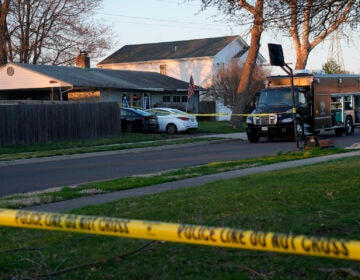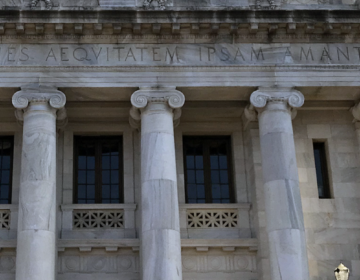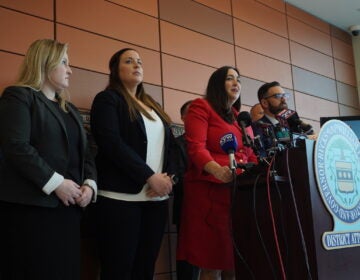Kratz guilty in gruesome 2017 slaying of three men at Bucks County farm
A Bucks County jury has reached a mixed verdict in the case of Sean Kratz, convicting him of first- and second-degree murder, and finding him guilty of voluntary manslaughter.
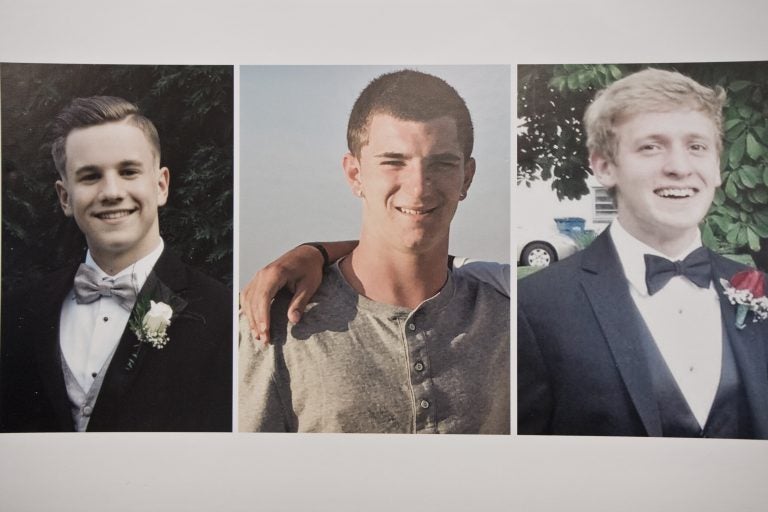
(From left) Jimi Patrick, 19, Dean Finocchiaro, 19, and Thomas Meo, 21, along with Mark Sturgis, 22, (not pictured) were murdered in July 2017. Sean Kratz was found guilty of first-degree murder for the slaying of Finocchiaro and guilty of voluntary manslaughter in the deaths of Meo and Sturgis. Kratz's cousin, Cosmo DiNardo is serving four life sentences for the murders of the four men. (Kimberly Paynter/WHYY, file)
Updated: 2:25 p.m.
—
A Bucks County jury has reached a mixed verdict in the case of Sean Kratz, convicting him of first- and second-degree murder in the slaying of one of the three men killed at a Solebury Township farm in July 2017, and finding him guilty of voluntary manslaughter in the deaths of the other two.
Jurors found Kratz guilty of first- and second-degree murder in the death of Dean Finocchiaro, 19. The voluntary manslaughter convictions come in the killings of Tom Meo, 21, and Mark Sturgis, 22. Kratz was also convicted of abuse of corpse in all three deaths, and related robbery, conspiracy and weapons possession charges.
Kratz, 22, faces the death penalty because of the first-degree murder conviction. The penalty phase of the trial is scheduled to begin Monday.
His cousin, Cosmo DiNardo, is currently serving four life sentences for the murders of those three men as well as a fourth, Jimi Patrick, 19.
Members of the victims’ families declined to comment after the verdict.
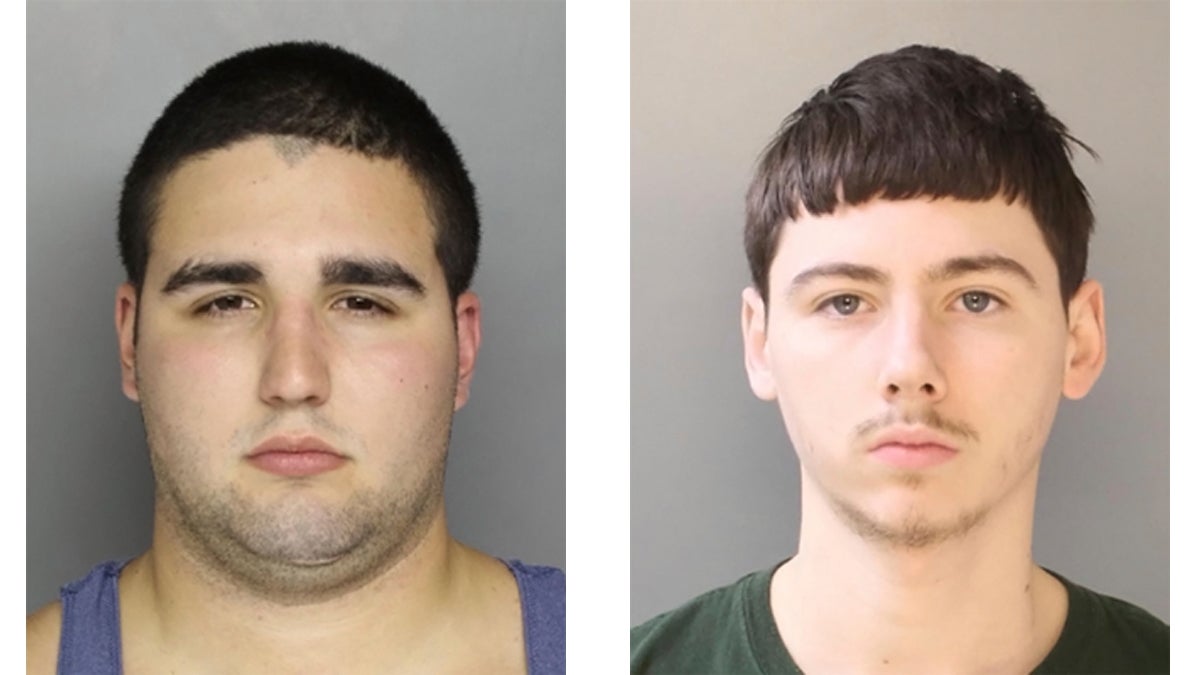
The jury resumed its work Friday morning, after 14 hours of deliberation Wednesday and Thursday. They had asked the judge a series of questions, including whether they could convict Kratz on both first- and second-degree murder charges and whether the judge could specifically define conspiracy to commit abuse of a corpse.
Jurors also asked to watch two confession tapes again. In the first, they asked to see a specific portion of the tape in which Kratz talks to his mother, Vanessa Amodei, and expresses distress and confusion regarding the police interrogation. “You need to be as honest and as clear as you can be,” Amodei told her son.
The second tape, which the jurors watched in its nearly 90-minute entirety, shows Kratz discussing the details of the murders with Detective Martin McDonough, with his original lawyer, Craig Penglase, by his side.
The case captured national attention for its gruesomeness and seeming lack of motive. The victims went missing for days, beginning July 5, 2017, when DiNardo killed Patrick after proposing to sell him $8,000 worth of marijuana. Patrick only had $800, so DiNardo offered to sell him a gun, then shot him and buried Patrick on his family’s farm in Solebury.
On July 7, 2017, DiNardo returned to the 100-acre farm with Kratz. They lured Finocchiaro there first under the guise of a drug deal. On a leaked confession tape, Kratz says DiNardo gave him a gun and made him take Finocchiaro for a ride on a four-wheeler and was supposed to take him into the woods and kill him.
“I just couldn’t do it,” Kratz says on the tape, and he brought Finocchiaro back to the farm’s barn, where he says DiNardo forced him to use the gun. He says he closed his eyes and shot Finocchiaro, wounding him. DiNardo took the gun and finished the job, killing Finocchiaro. Kratz says he threw up outside the barn, and his cousin laughed: “Relax, you never seen a dead body?”
DiNardo went through Finocchiaro’s pockets, taking his cell phone and money, and loaded his body into the drum of a pig roaster. Kratz claims he was not involved with that process. “I never touched his body,” he says.
Later that same day, DiNardo lured Meo and Sturgis to the farm for another supposed drug deal. DiNardo shot them while Kratz stood watch. DiNardo ran over Meo’s body with a backhoe and then both bodies were loaded into the pig drum along with Finocchiaro’s. DiNardo doused the bodies with gasoline and set them on fire, first trying to do so with a box of matches and, when that didn’t work, using Kratz’s lighter.
Authorities traced a signal from Finocchiaro’s cellphone to the DiNardo farm on July 8 and found three of the bodies. DiNardo ultimately led them to the fourth, as part of an agreement that he would not face the death penalty.
DiNardo entered a plea deal that Kratz was also supposed to be a part of, but at the last minute Kratz changed his mind and backed out of the deal, sending his case to trial. (In one of their initial questions for the judge, the jurors asked why Kratz turned down that plea deal. Bucks County Court Judge Jeffrey L. Finley told the jury that was not pertinent to the trial or their verdict).
At the time, Kratz argued that his then-lawyer had bungled the case. The lawyer, Craig Penglase, later admitted leaking Kratz’s confession tape to the media.
Penglase was mentioned as a potential defense witness in Kratz’s trial but did not testify. Neither did Kratz, whom his lawyer, Charles Peruto, had promised in opening statements would take the stand. But in a surprise twist Tuesday, the defense rested after calling only DiNardo’s parents and Kratz’s sister to the stand.
DiNardo had been subpoenaed as a witness for the prosecution, but he refused to leave his jail cell to testify.
Kratz’s attorneys had argued that he was an “idiot” who was too afraid of his “lunatic” cousin, DiNardo, to stop him from committing murder. Judge Finley instructed the jury that duress as a defense only applies when the person was coerced by a threat or use of force and did not knowingly put himself in a position where he could expect to be coerced in such a way.
The confession tapes, which the jury watched both during the trial and during deliberations, played an important role. In his instructions to the jury, Judge Finley emphasized assessing whether Kratz’s confession was voluntary, a product of a rational mind and free will. Finley noted that in the first of the two confession tapes, Kratz had been read his Miranda rights, whereas in the second he had not, but his attorney had been present.
According to detectives who testified in the case, Kratz sent text messages to his girlfriend and mother in the days after the murders, arranging a date with his girlfriend and asking his mother to buy him a new pair of shoes. Kratz and DiNardo also went for cheesesteaks at Steve’s Prince of Steaks after the murders.
WHYY is your source for fact-based, in-depth journalism and information. As a nonprofit organization, we rely on financial support from readers like you. Please give today.


